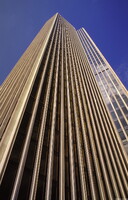Governor Nelson A. Rockefeller Empire State Plaza
Harrison and Abramovitz; Harrison, Wallace Kirkman

Download1A1-HW-ES-C7_cp.jpg (519.2Kb)
Alternative Title
Empire State Plaza
Date
1965-1978Description
Looking up an Agency building on the east side; The complex consists of ten buildings set up on a 6-story platform, which forms the plaza. The long passageway with three reflecting pools along the length is bordered on the west by the four Agency buildings and on the east by the tall Corning Tower and the so-called Egg. "The Cultural Education Center, raised on its own platform, is at the south end while the 19th century State Capitol closes off the north end. Originally called the Empire State Plaza but later renamed for the governor who initiated the project, this complex is one of the most ambitious urban renewal projects in modern U. S. history. It was initially controversial for a number of reasons: the displacement of thousands of residents and small businesses, the cost (including the use of luxury materials like the omnipresent marble sheathing), and the inefficient use of space. While these practical criticisms have largely dissipated, particularly since the plaza is a huge tourist attraction as well as important for local use, still the complex is often criticized on aesthetic grounds. The architecture is described as outmoded and the buildings as pompous. And worse, some critics see symbolic links to Fascist architecture and centralized powerful governments. Robert Hughes, for example, in The Shock of the New, calls its style the "International Power Style of the Fifties." Others, however, praise the complex of buildings for not being trendy and predict this architecture will stand the test of time." Source: Digital Imaging Project, Mary Ann Sullivan, Bluffton University; http://www.bluffton.edu/~sullivanm/ (accessed 1/1/2008)
Type of Work
legislative building; museum; concert hallSubject
architectural exteriors, contemporary (1960 to present), City planning, Modernist
Rights
Rights Statement
Licensed for educational and research use by the MIT community only